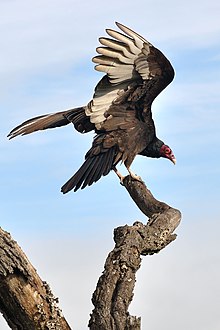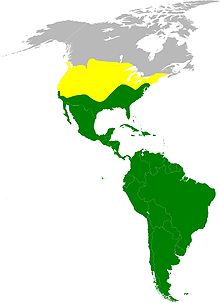
Hi Everybody!!
As Turkey Day is rolling in tomorrow, there is a bunch of 'turkey talking' going on. Tonight, I am going to show You one "Turkey" that will not be cooked and served by any human! I am talking about the Turkey Vulture and/or Turkey Buzzard.
These birds may have turkey in their name, but they are not Turkeys. Buzzards are Birds of Prey. To the World, they are known as the cleanup crew. They eat animals that have died in the fields or roads. (More info. below). Thanksgiving just happens to be the time of year the buzzards migrate back to Rainbow Creek and my Bird Sanctuary. They will be in and out of my trees now until March when they migrate to new hunting ground. I found some photos in my G+ Albums of these same birds going back a few years and I have shared them below. If you ever get a chance to know these birds, you will discover not only are they very smart, they are so funny also! Enjoy!



link to album: https://plus.google.com/photos/102505667655735408566/albums/5582304866117091329?banner=pwa
album link: https://plus.google.com/photos/102505667655735408566/albums/5684305596790991137/5684305724678021650?banner=pwa&pid=5684305724678021650&oid=102505667655735408566
album link: https://plus.google.com/photos/102505667655735408566/albums/5685031306826814529?banner=pwa
This was yesterday morning: (COLDDDDDDDD)


link to Album Photostudy:
https://plus.google.com/u/0/photos/117645114459863049265/albums/5950694037280480225





https://en.wikipedia.org/wiki/Turkey_Vulture
Turkey Vulture
From Wikipedia, the free encyclopedia
The Turkey Vulture (Cathartes aura), also known in some North American regions as theturkey buzzard (or just buzzard), and in some areas of the Caribbean as the John crowor carrion crow,[2] is the most widespread of the New World vultures.[3] One of three species in the genus Cathartes, in the family Cathartidae, the Turkey Vulture ranges from southern Canada to the southernmost tip of South America. It inhabits a variety of open and semi-open areas, including subtropical forests, shrublands, pastures, and deserts.[1]
It, like all New World vultures, is not related to the Old World vultures of Europe, Africa, and Asia. It looks nearly identical because of convergent evolution, where natural selection similarly shapes unrelated animals adapting to the same conditions.
The Turkey Vulture is a scavenger and feeds almost exclusively on carrion.[4] It finds its food using its keen eyes and sense of smell, flying low enough to detect the gases produced by the beginnings of the process of decay in dead animals.[4] In flight, it usesthermals to move through the air, flapping its wings infrequently. It roosts in large community groups. Lacking a syrinx—the vocal organ of birds—its only vocalizations are grunts or low hisses.[5] It nests in caves, hollow trees, or thickets. Each year it generally raises two chicks, which it feeds by regurgitation.[6] It has very few natural predators.[7] In the United States, the vulture receives legal protection under the Migratory Bird Treaty Act of 1918.[8]
Taxonomy[edit]
The Turkey Vulture received its common namefrom the resemblance of the adult's bald red head and its dark plumage to that of the maleWild Turkey, while the name "vulture" is derived from the Latin word vulturus, meaning "tearer," and is a reference to its feeding habits.[9] The word buzzard is used by North Americans to refer to this bird, yet in the Old World this word refers to members of the genus Buteo.[10] The generic term Cathartesmeans "purifier" and is the Latinized form from the Greek kathartēs/καθαρτης.[11] The species name, aura, is Latinized from the Native Mexican word for the bird, auroura.[9] The Turkey Vulture was first formally described byLinnaeus as Vultur aura in his Systema Naturae in 1758, and characterised as V. fuscogriseus, remigibus nigris, rostro albo ("brown-gray vulture, with black wings and a white beak").[12] It is a member of the family Cathartidae, along with the other six species of New World vultures, and included in the genus Cathartes, along with the Greater Yellow-headed Vulture and the Lesser Yellow-headed Vulture. Like other New World vultures, the Turkey Vulture has a diploid chromosome number of 80.[13]
The exact taxonomic placement of the Turkey Vulture and the remaining six species ofNew World Vultures remains unclear.[14] Though both are similar in appearance and have similar ecological roles, the New World and Old World Vultures evolved from different ancestors in different parts of the world. Just how different the two are is currently under debate, with some earlier authorities suggesting that the New World vultures are more closely related to storks.[15] More recent authorities maintain their overall position in the order Falconiformes along with the Old World Vultures[16] or place them in their own order, Cathartiformes.[17] The South American Classification Committee has removed the New World Vultures from Ciconiiformes and instead placed them in Incertae sedis, but notes that a move to Falconiformes or Cathartiformes is possible.[14]
| Turkey Vulture | |
|---|---|
 | |
| At Santa Teresa County Park, San Jose, California, US | |
| Conservation status | |
| Scientific classification | |
| Kingdom: | Animalia |
| Phylum: | Chordata |
| Class: | Aves |
| Order: | Incertae sedis (disputed) |
| Family: | Cathartidae |
| Genus: | Cathartes |
| Species: | C. aura |
| Binomial name | |
| Cathartes aura (Linnaeus, 1758) | |
 | |
| Approximate range map: Summer only range Winter only range | |
...this is brendasue signing off from Rainbow Creek. See You next time!
https://plus.google.com/photos/102505667655735408566/albums/5582304866117091329/5582676376032496738?banner=pwa&pid=5582676376032496738&oid=102505667655735408566
*Note: I sell nothing online. There is no charge to see any of my stuff. Just fall in Love with Birds!
Brendasue Watson Photo Gallery from 2007:
https://plus.google.com/photos/102505667655735408566/albums?banner=pwa
O+O



No comments:
Post a Comment
Hi Everybody! Please say hello and follow so I know you are here! Due to the inconsideration of people trying to put commercials on my blog comment area, I have restricted use of anonymous posts. Sorry that some hurt all.
My public email is katescabin@gmail.com No spammers or trolls